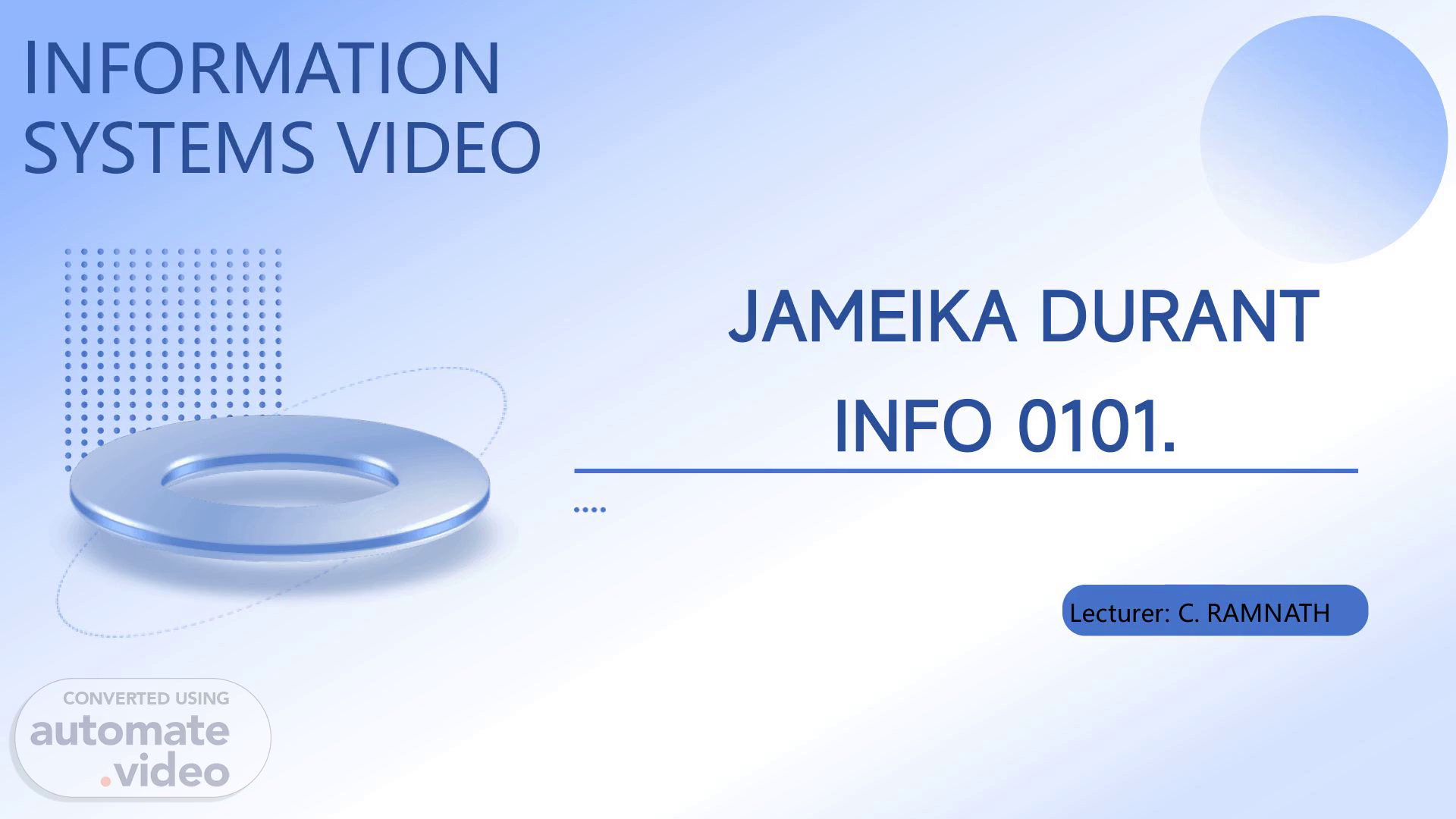Scene 1 (0s)
[Audio] INFORMATION SYSTEMS VIDEO JAMEIKA DURANT INFO 0101. Lecturer: C. RAMNATH.
Scene 2 (10s)
[Audio] Information Systems Defined 03 CONTENTS Common and Specialized types of Computing Devices 04 Common Computing Devices 04 Specialized Computing Device 05 What is the Internet? 06 Common Internet Services 07 Impact of Computing Devices and the Internet on Companies 08 and Information Systems. CONTENTS Impact of Computing Devices and the Internet on Companies and 09 Information Systems.
Scene 3 (40s)
[Audio] Information System Defined Organized System Combines Key Elements Supports Core Functions An information system is a It supports decision-making by The system combines people who structured framework that providing timely and accurate manage and use it, processes that integrates people, processes, information, coordinates activities define workflows, technology technology, and data to gather, across departments, enforces including hardware and software, process, store, and disseminate control, enables analysis, and and data resources to create information efficiently within an facilitates data visualization for organizational value. organization. better insights..
Scene 4 (1m 30s)
[Audio] Common and Specialized types of Computing Devices Common Computing Devices Common computing devices are everyday electronic machines designed for general use, such as performing tasks like communication, browsing the internet, creating documents, and entertainment. They are widely available and used by most people in daily life. Examples include: Desktop computers – often used at home, schools, and offices. Laptops – portable computers for work, study, or personal use. Tablets – touchscreen devices for media, reading, and apps. Smartphones – handheld devices for calls, messaging, apps, and internet access..
Scene 5 (2m 13s)
[Audio] Specialized Computing Devices Specialized computing devices are computers designed for specific functions or tasks rather than general everyday use. Unlike common devices, they usually serve a focused purpose in industries, businesses, or special environments. Examples include: Servers – manage networks, websites, and data storage. Supercomputers – perform complex calculations, often used in scientific research. Embedded systems – built into machines like cars, medical equipment, or appliances. Gaming consoles – optimized for playing video games. ATMs (Automated Teller Machines) – specialized for banking transactions..
Scene 6 (3m 3s)
[Audio] What is the Internet? What is the Internet? The Internet is a worldwide network of computers that are all connected together, allowing them to communicate, share data, and provide services. Think of it like a massive system of highways — computers, smartphones, and servers are the vehicles, and the Internet is the road system that lets them move information back and forth. It works by: 1. Devices (like your phone or laptop) connect to a local network (Wi-Fi, mobile data, etc.). 2. That network connects to a larger network (your Internet Service Provider, or ISP). 3. ISPs link together globally, forming the Internet. 4. Data is sent in packets across this network until it reaches its destination (like a website or another user)..
Scene 7 (4m 2s)
[Audio] Common Internet Services. Common Internet Services are online tools and platforms that allow users to communicate, share information, and access resources over the internet. They make every day online activities possible, from emailing to browsing. Examples include: 1. Email – sending and receiving messages (e.g., Gmail, Outlook). 2. World Wide Web (WWW) – browsing websites for information, shopping, or entertainment. 3. Social media – connecting and sharing content with others (e.g., Facebook, Instagram, Twitter). 4. Messaging & VoIP – chatting or calling online (e.g., WhatsApp, Zoom, Skype). 5. File Transfer – sharing files over the internet (e.g., Google Drive, Dropbox). 6. Online Streaming – watching videos, listening to music, or live broadcasts (e.g., YouTube, Netflix, Spotify). 7. E-commerce – buying and sellin goods and services online(e.g., Amazon, eBay, Shopify)..
Scene 8 (5m 19s)
[Audio] Impact of Computing Devices and the Internet on Companies and Information Systems Computing devices and the internet have transformed how companies use information systems. Businesses now rely on these systems for faster communication, efficient data management, online sales, automation, and global collaboration. As a result, companies view information systems as strategic tools that improve decision-making, productivity, customer service, and competitiveness in the global market. The rise of computing devices and the internet has transformed information systems from simple record-keeping tools into powerful platforms. Examples of these new innovations can be seen on the following slide.
Scene 9 (6m 4s)
[Audio] 1. Improved Communication: With computers, smartphones, and tablets connected to the internet, employees and management can communicate instantly through email, chat apps, or video calls. Impact: Companies can coordinate teams across different locations, respond faster to customers, and make quicker decisions. 1. Better Data Management and Analysis: Information systems now run on computers and cloud platforms, allowing companies to store, process, and analyze large amounts of data efficiently. Impact: Companies can make data-driven decisions, track performance, and predict trends, giving them a competitive edge. 1. E-Commerce and Online Presence: The internet allows companies to sell products and services online and reach customers globally. Impact: Businesses can expand markets, reduce costs, and provide personalized services, changing how they view traditional sales channels. 1. Automation of Processes: Computing devices running specialized software can handle repetitive tasks like inventory management, payroll, or customer service. Impact: This increases efficiency, reduces errors, and allows employees to focus on strategic work. 1. Global Connectivity: The internet enables companies to collaborate with international partners, suppliers, and clients. Impact: Companies can operate globally, source materials more efficiently, and provide round-the-clock services. 1. Security and Risk Management: With more reliance on internet-connected systems, protecting company data has become a priority. Impact: Companies invest in secure information systems, making them more strategic and vital to overall operations..
Scene 10 (8m 5s)
[Audio] THANK YOU!. THANK YOU!.
